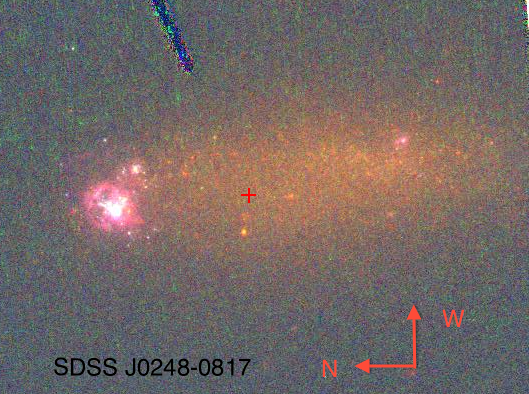







| BOOKS | F. A. Q. | ARTICLES | TALKS | ABOUT KEN | DONATE | BEYOND OUR KEN |
|---|
By Ken Croswell
Published in Scientific American (May 2013, page 19)

Credit: Hubble Space Telescope. NASA.
Giant spiral galaxies such as Andromeda and the Milky Way outshine and outweigh most of their galactic peers. They grew so large both by swallowing lesser galaxies and by grabbing gas from the space around them. New observations of exotic “tadpole” galaxies are shedding light on how the Milky Way assembled its most luminous component: the starry disk that is home to the Sun and Earth.
First spotted in the 1990s, tadpole galaxies sport bright heads, which spawn brilliant new stars, and long, faint tails. Most tadpoles are billions of light-years distant, meaning they were more common when the universe was young. From such great distances, though, studying the odd galaxies is difficult.
Jorge Sánchez Almeida of the Astrophysics Institute of the Canary Islands and his colleagues therefore scrutinized seven rare tadpoles that happen to lie much closer, within 600 million light-years of Earth. Analyzing light from telescopes on the island of La Palma, the astronomers determined the speeds of different parts of each galaxy, demonstrating that most of the tadpoles rotate, just as the disks of spiral galaxies do.
The astronomers also got a shock, however. In the Milky Way, oxygen abounds most in the bright star-rich central regions where massive stars forge oxygen and expel it when they explode. Yet the tadpoles exhibited the opposite oxygen pattern: their brilliant heads had less oxygen than their faint tails. “This is very strange,” Sánchez Almeida says.
To explain the surprising discovery, published in the April 10, 2013, issue of The Astrophysical Journal, the astronomers invoke pristine intergalactic gas, little altered since the big bang, the primordial inferno that produced only elements much lighter than oxygen. In this scenario, a stream of oxygen-poor gas slams into one section of a nascent galactic disk and triggers the birth of bright new stars, which light a tadpole's head but harbor little oxygen.
If this idea is right, celestial tadpoles resemble their terrestrial namesakes: they are primitive creatures that are growing larger. “The Milky Way could have done this,” says team member Bruce Elmegreen of IBM Research, who thinks tadpoles show how, billions of years ago, giant spiral galaxies gathered gas from their surroundings and built their spinning disks of stars, which ultimately grew into galactic superpowers like the Milky Way.
Ken Croswell earned his Ph.D. in astronomy from Harvard University and is the author of The Alchemy of the Heavens and The Lives of Stars.
"An engaging account of the continuing discovery of our Galaxy...wonderful." --Owen Gingerich, The New York Times Book Review. See all reviews of The Alchemy of the Heavens here.
"A stellar picture of what we know or guess about those distant lights."--Kirkus. See all reviews of The Lives of Stars here.
| BOOKS | F. A. Q. | ARTICLES | TALKS | ABOUT KEN | DONATE | BEYOND OUR KEN |
|---|